Mottainai: In Japan, creativity is key to a no-waste ideal
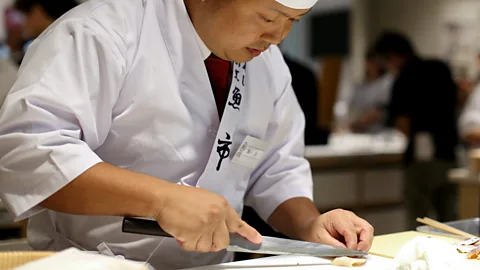 Bloomberg/Getty Images
Bloomberg/Getty ImagesJapan's celebrated principles of thrift and conservation further sustainability in the culinary world, brilliantly embracing scraps, leftovers and the whole animal.
The breezy fishing village of Murakami, only three hours by train from Tokyo, feels light-years removed from the hubbub of the world's largest city. I've come to the frozen-in-time castle town for respite from the rush and roar of urban Japan and to dine at Idutsuya, a renowned restaurant inside an inn once patronised by the 17th-Century poet and Zen master Basho.
In a dining room as serene as a Zen meditation hall, I relish a dozen distinct salmon delicacies presented like jewels on a lacquered tray. Pickled salmon milt. Crunchy, flash-fried skin. A pâté-like treat made from liver. The parade of briny bites is a symphony of flavours and textures, and every part of the fish, from the coveted o-toro (luxurious belly fat) to the organs, finds delicious expression. Even the bones and teeth are rendered into an umami-laden gel to be eaten atop rice. The meal – an edible ode to silky, orange fish flesh – beautifully expresses the Japanese ideal of mottainai, finding creative ways to eliminate waste.
Mottainai translates to English as "What a waste!" but the term most closely mirrors the old saying, "Waste not, want not." This ideal of minimising waste informs cultural quirks across Japanese life – hand-washing water recycled from sinks into toilets; old kimonos tailored into sumptuous scarves; or kintsugi, the tradition of restoring cracked pottery with molten gold seams – but nowhere is this principle more fully articulated than in the Japanese kitchen.
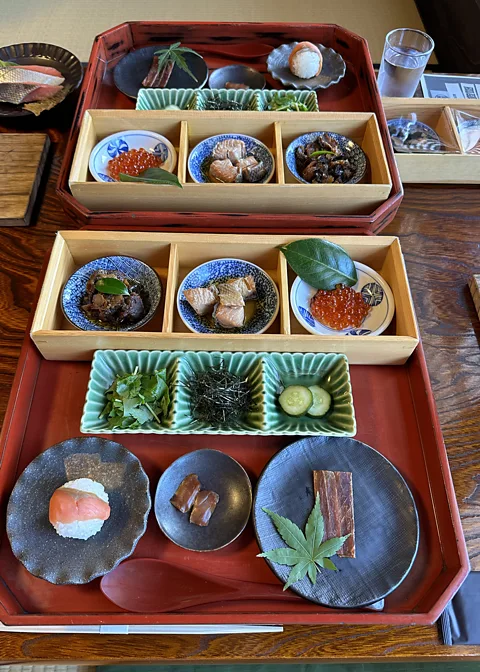 Johnny Motley
Johnny MotleyModern Japan boasts one of the highest GDPs in the world, but poverty and intermittent famines were harsh realities of rural villages not so long ago. Necessity being the mother of creativity, fishermen and farmers found ingenious ways to transform leftovers like peels, tough cuts of meat or sake lees into nourishing and delicious repasts. As with ratatouille in the French countryside or Italian pani câ meusa (bread stuffed with grilled organ meat), scarcity was the muse that inspired iconic Japanese dishes like ochazuke (green tea poured over leftover rice), kasuzuke (fish giblets pickled in sake) or kasu jiro (a hearty soup made from spent sake mash).
While mottainai harkens back to leaner times, the principle remains a pillar of even the most opulent sushi and kaiseki restaurants in the world. Finding ways to cook every part of a plant or animal not only reduces food costs and aligns with sustainability goals, but leftovers like stems, trimmings and viscera – "the nasty bits", to borrow a phrase from Anthony Bourdain – often yield the most memorable flavours in the hands of an expert chef.
A few kilometres inland from Murakami, in the shadow of the Japanese Alps, Satoyama Jujo is a Michelin-starred restaurant helmed by chef Keiko Kuwakino. After a stint as a globetrotting backpacker and stagiaire in kitchens from Australia to Europe and India, Kuwakino returned to Niigata to craft seasonal kaiseki menus celebrating the cornucopia of her home prefecture's lush valleys and cold waters. Obsessive about slashing food waste, Kuwakino draws inspiration from her grandmother's thrift.
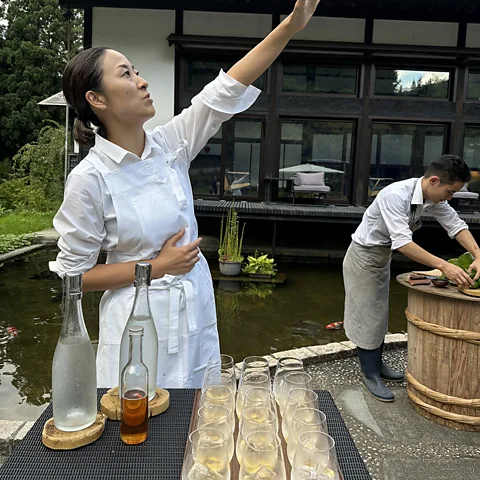 Johnny Motley
Johnny Motley"Grandma grew up in a village where resources were few and snow blanketed the ground for five months out of the year," recalled Kuwakino when I met with her in Satoyama Jujo's kitchen, a workspace walled with colourful jars of pickled roots and herbs. "She always insisted on not wasting even a single grain of rice, reminding my siblings and me of the toil and sacrifice required to grow rice," said Kuwakino. "I still this when I eat rice and cook it for my guests."
Although partial to flashy ingredients like caviar, uni and matsutake mushrooms, Kuwakino also has a knack for turning the humblest remnants into gourmet razzle-dazzle: leafy stems as decorative embellishment, fish skeletons turned into umami-packed stock and tough roots rendered into crunchy delights after a season of brining.
In the hours before dinner, Kuwakino and her team pulverise dehydrated fish bones into pungent powder – fairy dust as deliciously briny as an ocean breeze. The powder enlivens buttery wagyu and bowls of rice, and it shines in her kenchinjiru, a soup made of freshly picked seasonal vegetables such as aubergine, mushrooms and sweet potatoes. A dusting of the sea-salty particles renders the vegetables, submerged in a broth the colour of oolong tea, as richly savoury as marbled o-toro.
Even the peels discarded when preparing the vegetables for kenchinjiru find an afterlife. Armed with a dehydrator and grinder, Kuwakino alchemises beet, squash and carrot skins into vivid orange, yellow, and crimson powders. "I strive to stimulate all the senses with my food. I love vegetable powders not only for their earthy taste but also for the splashes of colour they add to dishes," Kuwakino explained.
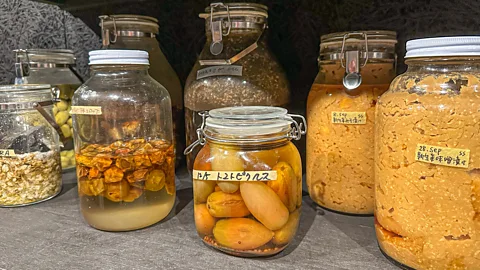 Johnny Motley
Johnny MotleyBefore beginning the first course – an amuse-bouche of fresh tofu, melon and pickled sardines – Kuwakino s me at my table to say the traditional Japanese grace of itadakimasu, an expression of gratitude for the life sacrificed for the meal. Mottainai resonates deeply with the tenets of Shinto, an ancient Japanese religion rooted in the animistic beliefs of the archipelago's prehistoric hunter-gatherer societies. "In Shinto, natural objects like wood, plants, animals and even stones have a sacred nature," said Kuwakino. "Things gathered from nature are imbued with kami (divine spirit)." The hallowedness ascribed to natural products raises mottainai to the level of sacred duty. Throwing away food – even scraps – is akin to sacrilege.
New York City sushi master Masa Takayama echoes the sentiment that squandering food, even water, induces a feeling of haji (shame or sadness). At Masa, a Manhattan omakase counter boasting triple Michelin Stars, Takayama uses every part of every fish on his cutting board, right down to bones, eyes and meat extracted from the head. "When I buy a fish, I that the fish once had a life. Out of respect for the creature, I find ways to cook everything," Takayama said. While the most delicate cuts of fish become sashimi, Takayama boils down heads, tails and skeletons to make sauces for nightly specials or for makanai, the staff family meal.
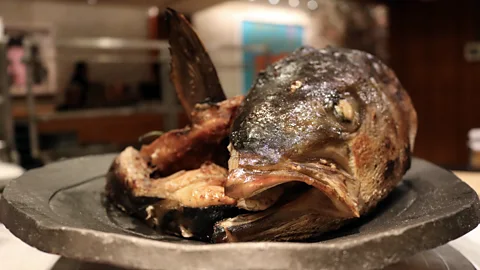 Kappo Masa
Kappo MasaA perennial special on Masa's menu is grilled buri head. The fish, yellowtail amberjack, is flown in from Tokyo's fish markets daily and yields ghost-white, near-translucent sashimi – ethereally light, mildly briny flesh bathed in ponzu sauce and garnished with shiso flowers. But the real piece-de-resistance, said Takayama, is the skull, a mass of bone jacketed with marbled flesh. "Growing up in Japan, my parents would save fish heads to braise with soy sauce and the leftover juices from making tofu," said Takayama. "The head meat, where the fish stores much of its fat, gives us the best umami flavour." After a soy sauce marinade and light grilling, the head meat, soft as jelly and ornamented with charred shishito peppers, is indeed the soul of umami richness.
Back in Murakami, I meander down the village's narrow, stone-cobbled alleys to Kokonoen, a cosy tea parlour constructed of sandy-coloured Japanese cypress. Seated in front of a manicured Zen garden, I sip fragrant sencha – liquid jade as perfumed and complex as an aged Pinot Noir – paired with chazuke (jewel-like confections of preserved strawberries, mulberries and other local fruits). Each pour from the lacquered tea kettle conjures up new flavours from the aromatic leaves, subtleties to be contemplated along with the beauty of the garden and the calligraphy.
The leaves finally spent, the tea master gently removes them from the teapot with wooden tongs and settles them atop a bowl of fresh rice. Bright green and as tender as steamed spinach, the sencha releases the last hints of the tea's marine and pine bouquet. Lifted by caffeine and theobromine, I can't help but agree with the Shinto sages. The blessings of nature are sacred. Miracles of soil, sun and rain too precious to simply throw away.
Serves 1
For chef Masa Takayama, okara with leftover veggies is a home-cooked meal embodying the spirit of mottainai. Traditionally, okara is the soy pulp or tofu dregs left after pureed soybeans are filtered in the production of soy milk and tofu. But here, you can use extra soft tofu found at most Asian markets.
Ingredients
35g soy sauce
35g sugar
35g leftover stock after cooking leftover cooked bones of meat, fish or chicken
sesame oil
100g vegetables (mushrooms, kale, or spinach are delicious options, but any vegetables are fine. Chef Takayama uses any unused chopped vegetables he has lying around his kitchen)
100g okara or extra-soft tofu
100g water
cooked rice (optional)
Method
Step 1
Create a sauce by combining the soy, sugar and whatever leftover stock you have on hand in a saucepan. Boil gently until combined.
Step 2
In a frying pan, heat the oil and sauté the chopped vegetables until soft.
Step 3
In a pot, combine the okara with the sauce and water and boil gently until well combined. Serve the okara sauce alongside the sautéed vegetables and rice.
BBC.com's World's Table "smashes the kitchen ceiling" by changing the way the world thinks about food, through the past, present and future.
---
